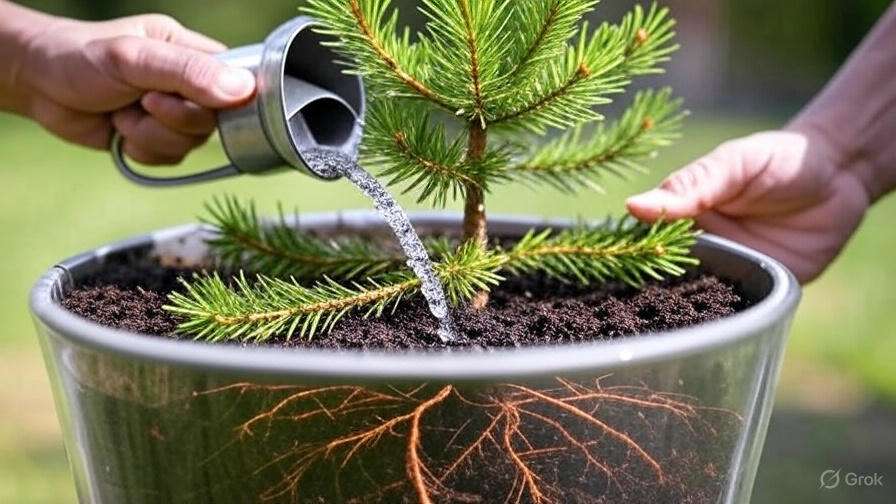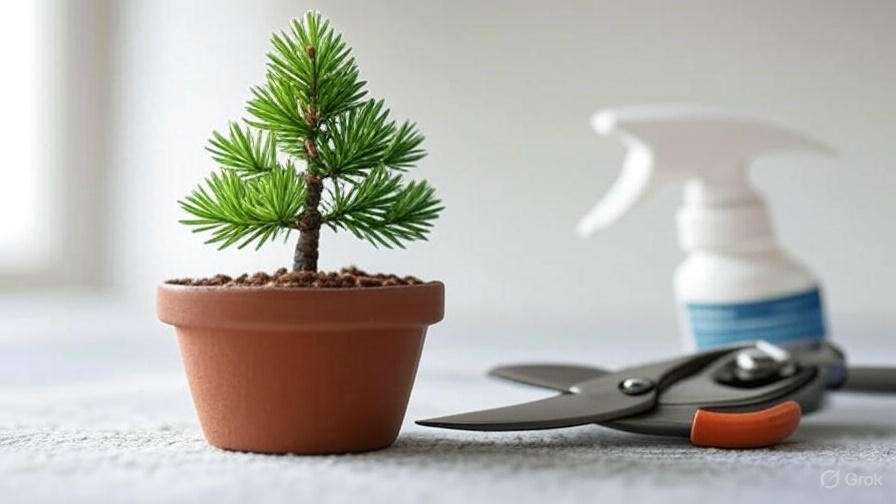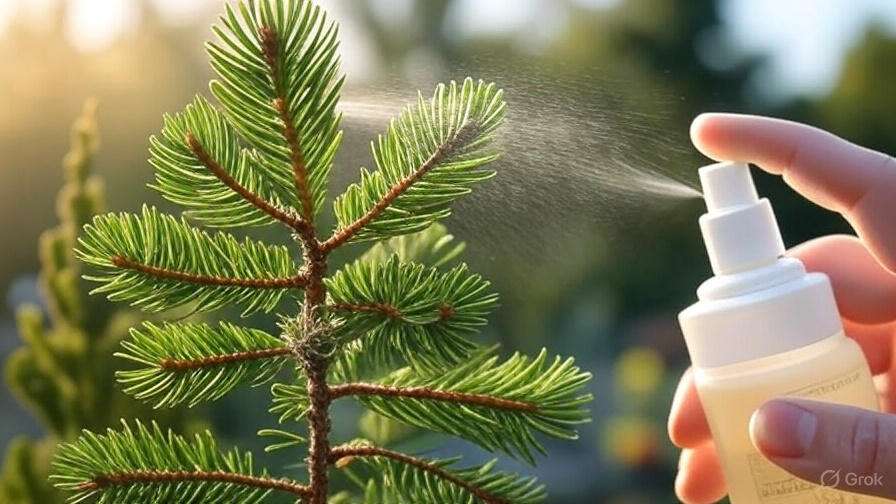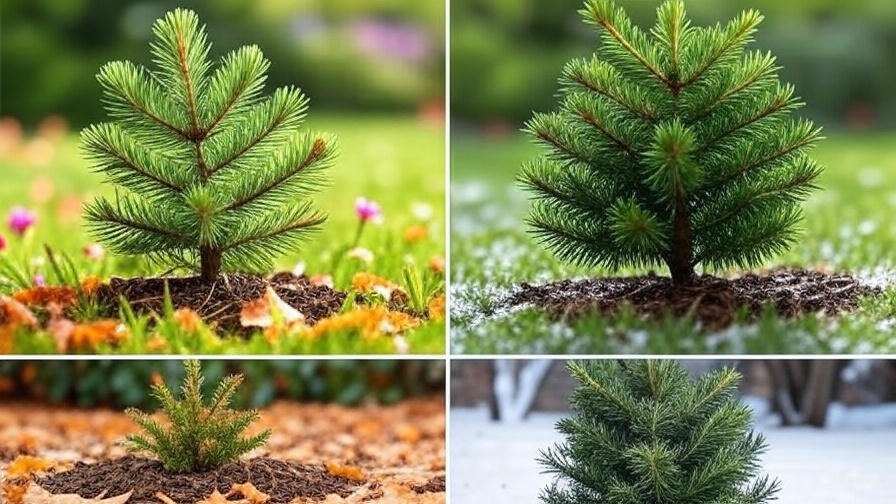
How to Care for a Tiny Pine Tree: Essential Tips for Healthy Growth and Longevity
Tiny pine trees are the perfect addition to any small garden, balcony, or indoor space. 
In this guide, we’ll walk you through the essential tips to ensure your tiny pine tree grows strong, vibrant, and long-lasting. Whether you’re new to gardening or an experienced plant lover, these practical steps will help you nurture your tiny pine tree to perfection. Ready to learn how to make your tiny pine tree flourish? Let’s dive in!
Table of Contents
ToggleUnderstanding Your Tiny Pine Tree 
Taking care of a tiny pine tree might seem intimidating at first, but with the right knowledge, you can help your little tree thrive. Let’s break down the essential things you need to know to provide the best care for your pine tree, whether it’s growing indoors or outdoors.
1. Pine Tree Basics 
Pine trees are hardy, evergreen conifers that are typically known for their tall stature. However, when young, they grow more compact and slow. Your tiny pine tree has specific needs in terms of sunlight, water, and soil conditions, which we’ll cover below.
2. Sunlight is Key 
Pine trees love sunlight! Make sure your tiny pine gets at least 4-6 hours of direct sunlight every day. If you’re growing it indoors, place it near a south-facing window where it can bask in the light. 
3. Watering with Care 
Overwatering is a common mistake. While your pine tree needs water, it doesn’t like to sit in soggy soil. A good rule of thumb is to water when the top 1-2 inches of soil feel dry to the touch. Use a well-draining pot or ensure the ground outside has proper drainage to prevent root rot.
In winter, when growth slows down, reduce the watering frequency since the tree is less active. Be sure not to let the soil completely dry out during this time, though!

4. Soil Type Matters 
Pine trees thrive in well-draining, acidic soil. If you’re growing your tree in a pot, use a mix designed for conifers or evergreens. Outdoors, pine trees typically prefer sandy or loamy soil. Ensure the soil is slightly acidic (pH of 5-6) to provide the nutrients your tree needs for strong, healthy growth.
5. Pruning for Shape 
Pruning is important for maintaining the shape of your tiny pine. Remove dead or yellowing branches to allow room for new growth. Trim back any unwanted growth to help it develop a fuller, more balanced shape. However, avoid excessive pruning since it can stunt growth, especially in younger trees.
Prune your tree during late winter or early spring before the growing season kicks in for the best results.
6. Temperature Tolerance 

Pine trees are known for their hardiness and can survive a wide range of temperatures. However, extremes in heat or cold can stress a tiny pine. If you’re growing it indoors, keep it in a room where temperatures range from 50-70°F (10-21°C). Outdoors, they can handle freezing temperatures, but young pines may need protection during extreme cold spells.
7. Fertilizing for Growth 
Fertilizing is key to helping your tiny pine tree grow strong and healthy. Use a slow-release, balanced fertilizer during the spring and summer months to promote growth. Avoid over-fertilizing, as too many nutrients can harm your tree. One to two feedings per growing season is usually sufficient.
8. Watch for Pests and Diseases 
Tiny pine trees can be susceptible to pests like aphids, scale insects, or spider mites, and diseases such as pine needle blight. Regularly inspect your tree for signs of trouble, such as yellowing needles, holes in the leaves, or a sticky residue on the branches. If you spot anything suspicious, treat it promptly with organic pest control or consult a gardening expert.
By understanding these basic needs and keeping an eye on your pine’s health, you can watch it grow strong and tall, bringing beauty and natural charm to your space for years to come!
Essential Care Tips for a Healthy Tiny Pine Tree 
Caring for a tiny pine tree is an incredibly rewarding experience. Whether you’re growing it indoors or outdoors, following these simple care tips will ensure it thrives and grows strong. Here’s what you need to know to keep your little pine tree happy and healthy:
1. Choose the Right Location 
Tiny pine trees love plenty of sunlight! 
2. Water Properly 
Watering is key to keeping your pine tree healthy. Keep the soil consistently moist, but never soggy. A good rule of thumb is to water when the top inch of soil feels dry. During colder months, reduce watering since the tree’s growth slows down.
3. Ensure Good Drainage 
Proper drainage is crucial to avoid root rot. If your pine tree is in a pot, make sure it has drainage holes at the bottom. Outdoors, ensure the soil drains well—pines prefer slightly acidic, well-draining soil. If the soil is heavy, mix in some sand to improve drainage.
4. Avoid Over-Fertilizing 
Pine trees don’t need heavy feeding. Fertilize lightly during the growing season (spring and early summer) using a balanced, slow-release fertilizer. Over-fertilizing can lead to weak growth and damage to the tree’s roots.
5. Prune Regularly 
While tiny pines don’t require much pruning, removing dead or damaged branches will help your tree grow strong. Aim to trim away any unhealthy growth in late winter or early spring, just before new growth starts. Always use clean, sharp tools to avoid spreading disease.
6. Protect from Pests and Diseases 
Keep an eye out for common pests like aphids, pine beetles, or spider mites. These tiny invaders can harm your tree, so check your pine regularly for signs of damage. If you spot any pests, treat the tree with an eco-friendly insecticidal soap or neem oil. Regularly removing dead leaves and debris can also help prevent fungal infections.
7. Provide Proper Winter Care 
Tiny pine trees can be sensitive to extreme cold. If your tree is outside, consider covering it with burlap or frost cloth to protect it during harsh winters. If it’s in a pot, consider moving it to a sheltered spot during freezing weather.

8. Repot When Necessary 
Pine trees in pots may outgrow their containers. Repot your tiny pine every 1-2 years to provide it with more space to grow. Choose a pot that is 2 inches larger than the current one and make sure it has proper drainage holes.
9. Monitor Growth and Health 
Regularly check the overall health of your tiny pine tree. Look for signs of stress, such as yellowing needles, stunted growth, or browning tips. If you notice any of these issues, adjust your care routine to ensure your tree’s well-being.
Final Thoughts 
Caring for a tiny pine tree is simple once you get the basics down. With the right amount of sunlight, water, and attention, your tree will flourish for years to come. Keep it happy, healthy, and free from pests, and you’ll enjoy watching your little pine grow into a magnificent tree 
Pruning and Shaping Your Tiny Pine Tree 

Pruning and shaping your tiny pine tree is a crucial part of maintaining its health and enhancing its appearance. Done correctly, it encourages strong growth, prevents disease, and helps your tree develop a balanced, attractive form. Here’s how to do it right:

1. Why Prune Your Tiny Pine Tree? 
Pruning removes dead, damaged, or diseased branches, allowing the healthy ones to thrive. It also helps control the tree’s shape, size, and overall aesthetic. For tiny pines, proper pruning ensures they grow strong and maintain a compact, attractive form, perfect for small spaces.
2. Best Time to Prune 
The best time to prune a tiny pine tree is in early spring, just before the new growth begins. This timing allows your tree to heal quickly and encourages fresh, healthy shoots. Avoid pruning in the fall or winter when the tree is dormant, as this could expose it to harsh conditions.
3. Tools You’ll Need 
- Sharp Pruning Shears: For small branches and precise cuts.
- Loppers: For thicker branches.
- Gloves: To protect your hands while working.
Make sure your tools are clean to avoid spreading disease.
4. Pruning Techniques 
- Remove Dead or Damaged Branches: Look for any branches that are broken, discolored, or dying. Cut these back to healthy tissue to prevent the spread of disease.
- Shape the Tree: Lightly trim the tips of branches to encourage bushier growth. Be sure to prune evenly around the entire tree to maintain its natural shape.
- Thin Out Crowded Areas: If your tree has many branches growing too close together, remove some to allow better airflow and light penetration.
5. Avoid Over-Pruning 
Don’t cut away too much of the tree’s foliage. Pine trees rely on their needles for photosynthesis, so removing too many branches can weaken the tree. Stick to removing 20% or less of the tree’s foliage in a single pruning session.
6. Watch Out for the Leader Stem 
If your tiny pine tree has a central leader (the main upright stem), be sure not to damage it. This stem is crucial for the tree’s overall height and shape. If it gets damaged, it can affect the tree’s growth direction and balance.
7. Final Touch: Clean Up 
After pruning, clear away any cuttings from around the base of the tree. This keeps the area tidy and prevents pests or mold from taking hold.
Pro Tips for Shaping Your Tiny Pine Tree 
- Use Caution with Bonsai Styles: If you’re going for a more stylized, bonsai-like shape, be patient. Shaping a tiny pine takes time, and over-pruning can lead to an imbalanced look.
- Pinching New Growth: Lightly pinch off the new growth tips during the growing season to encourage a denser, more compact form.
By following these simple pruning and shaping steps, your tiny pine tree will not only grow stronger and healthier but will also look more beautiful and well-maintained. 
Protecting Your Tiny Pine Tree from Pests and Diseases 

Caring for a tiny pine tree means keeping a close eye on its health and protecting it from pests and diseases that can harm its growth. If left unchecked, these problems can stunt your tree’s development or even kill it. Let’s dive into how you can spot potential issues early and prevent them from damaging your tiny pine.

1. Keep an Eye Out for Common Pests 
Pine trees are susceptible to a variety of pests, but some of the most common ones include:
- Aphids: These small insects suck sap from your tree, leading to yellowing needles and stunted growth. You can spot aphids by the sticky residue (called honeydew) they leave behind. Treat with insecticidal soap or a strong jet of water to wash them off.
- Pine Needle Scale: This pest covers itself with a hard, protective shell and can be tricky to notice. Look for yellowing or browning needles. To control it, apply horticultural oil during the dormant season, as it suffocates the insects.
- Spider Mites: These tiny creatures can cause your pine tree’s needles to become speckled or dusty. If you see webs between branches, you likely have spider mites. To get rid of them, spray your tree with a mixture of water and mild dish soap or use a miticide.
2. Watch for Signs of Disease 
Diseases can also take a toll on your tiny pine tree. Some common ones to be aware of include:
- Needle Blight: This disease causes the needles to turn yellow or brown, eventually falling off. It’s often caused by fungal infections. Prune affected branches and remove fallen needles from around your tree. Fungicides can also help prevent the spread.
- Root Rot: This happens when the tree’s roots become waterlogged or suffer from poor drainage. Roots will rot and cause the tree to weaken. Make sure your tree is planted in well-draining soil and avoid overwatering. If root rot is suspected, you may need to replant your pine in fresh soil.
- Rust: Pine trees are prone to rust, a fungal disease that leaves orange or yellow spots on the needles. If you spot this, prune the infected areas and dispose of them far away from your tree. A fungicide can help prevent the spread.
3. Preventative Measures 
Preventing pests and diseases is often easier than dealing with them after they’ve already affected your tree. Here are a few proactive steps you can take:
- Regularly Inspect Your Tree: Walk around your pine tree every few weeks and look closely for any signs of pests or disease. Catching problems early can save you a lot of trouble later.
- Maintain Proper Watering and Fertilization: A healthy, well-fed pine is less likely to succumb to pests and diseases. Water your tree correctly (deep watering is better than frequent shallow watering), and provide it with the nutrients it needs to thrive. Be careful not to over-fertilize, as this can weaken your tree.
- Prune Dead or Infected Branches: Regular pruning helps to remove areas that pests and diseases could target. Make sure to dispose of any infected branches properly to prevent the spread of disease.
4. Natural Remedies 
If you’re looking for natural solutions to protect your tiny pine tree, consider using:
- Neem Oil: This natural oil is effective against a wide range of pests and diseases. It works as both a pesticide and fungicide, helping to protect your pine without harmful chemicals.
- Garlic or Hot Pepper Spray: Mix garlic or hot peppers with water to create a homemade pest repellent. This can help deter insects from settling on your tree.
5. Keep the Area Clean 
A clean environment around your pine tree can reduce the chances of pests and disease. Remove fallen needles, leaves, and other debris regularly. This not only keeps pests at bay but also reduces the risk of fungal infections.
Conclusion 
By staying vigilant, following a simple maintenance routine, and applying natural or chemical solutions when necessary, you can protect your tiny pine tree from the most common pests and diseases. A little care goes a long way, ensuring your tree remains healthy, vibrant, and growing strong for years to come!
Seasonal Care for Tiny Pine Trees 
Caring for a tiny pine tree involves adjusting your approach to match the changing seasons. By following the right practices during each season, you can ensure your pine tree grows strong, healthy, and happy year-round.

Spring  : Awakening and Growth
: Awakening and Growth
Spring is when your tiny pine tree starts to come back to life after the cold winter months. Here’s what you should focus on:
- Watering: As temperatures rise, your pine tree will need more water to support its growth. Make sure the soil stays consistently moist but not waterlogged. A deep watering once or twice a week is usually sufficient.
- Fertilizing: Spring is a great time to give your pine tree a boost with a slow-release fertilizer. Look for one that’s specifically designed for conifers. This will support the growth of new shoots and help your tree develop a strong root system.
- Pruning: Trim away any dead or damaged branches to encourage healthy new growth. Be gentle and avoid cutting too much—your tiny pine tree will benefit from light pruning.
Summer  : Thriving in the Heat
: Thriving in the Heat
Summer can be tough for tiny trees, especially in hotter climates. Here’s how to help your pine tree thrive:
- Shade Protection: If temperatures soar, consider providing some shade for your tree during the hottest part of the day. You can use a garden umbrella or shade cloth to protect it from direct sunlight.
- Watering: During summer, your pine tree may need more frequent watering. Ensure the soil remains moist but not soggy. Check the soil every few days and water as needed.
- Pest Control: Keep an eye out for pests like aphids or pine beetles. If you spot any, treat your tree with an organic insecticidal soap or neem oil. Healthy trees are better at resisting pests, so consider fertilizing lightly if needed.
Fall  : Preparing for Dormancy
: Preparing for Dormancy
As the weather cools down, your tiny pine tree begins to prepare for winter dormancy. Here’s how to guide it through the fall:
- Watering: As temperatures drop, reduce watering, but don’t let the soil dry out completely. Watering once every 7–10 days should be enough. Make sure the soil has good drainage to prevent root rot.
- Mulching: Apply a layer of mulch around the base of your pine tree to protect the roots from frost. Organic mulch, like pine bark or wood chips, works best. Keep the mulch a few inches away from the trunk to avoid moisture buildup.
- Pruning: Avoid heavy pruning in the fall. Only remove dead or damaged branches to ensure the tree stays healthy through the colder months.
Winter  : Winterizing for Survival
: Winterizing for Survival
Winter can be tough on tiny pine trees, especially if they’re young. Proper care will help them survive the cold:
- Watering: Though it may seem counterintuitive, water your pine tree during the winter when the ground is not frozen. A deep watering once or twice a month is typically enough, as long as the tree is not covered by snow.
- Protection from Frost: In colder climates, protect your tiny pine from extreme frost. You can wrap it in burlap or create a simple frame to keep the wind and snow off the tree. Be sure to remove the covering on warm, sunny days to allow the tree to breathe.
- Avoid Salt Exposure: If you live in an area that uses road salt, be mindful of salt exposure to your tree. Salt can damage the roots and the tree’s overall health, so make sure it’s not splashed onto the base or the soil.
By following these seasonal care tips, your tiny pine tree will be well-equipped to grow and thrive through every season 
Conclusion
Caring for a tiny pine tree is both rewarding and manageable with the right knowledge and attention. By following the tips we’ve shared—choosing the right location, watering properly, pruning thoughtfully, and protecting your tree from pests and diseases—you can ensure that your tiny pine tree thrives and brings beauty to your space for years to come.
Whether you’re growing it indoors or in your garden, these evergreen trees will add charm and a touch of nature to any environment. Remember, consistency and patience are key—tiny pine trees may grow slowly, but with the right care, they’ll reward you with vibrant, healthy growth and a lasting presence.
Start applying these expert tips today, and enjoy the beauty of your tiny pine tree as it flourishes in its new home!
Frequently Asked Questions(FAQ)
Can I grow a tiny pine tree indoors?
Yes, tiny pine trees can thrive indoors with adequate light. Place them near a bright window with at least 4-6 hours of indirect sunlight daily. Be mindful of temperature changes from drafts and heating vents, which can stress the tree.
How often should I water my tiny pine tree?
Water your tiny pine tree when the top 1-2 inches of soil feel dry to the touch. Ensure the tree is in a well-draining pot or soil to avoid waterlogging, which can lead to root rot. In winter, reduce watering as the tree enters a dormant phase.
Why are the needles on my tiny pine tree turning yellow?
Yellowing needles can be caused by overwatering, poor drainage, or a nutrient deficiency. Ensure the soil drains well and check the watering schedule. If the problem persists, consider adding a balanced fertilizer to boost nutrients.
Can I prune my tiny pine tree, and when is the best time to do it?
Yes, you can prune your tiny pine tree to maintain its shape and remove dead or damaged branches. The best time to prune is late winter or early spring before new growth starts. Always use sharp, clean pruning shears to make clean cuts.
How do I protect my tiny pine tree from pests?
Common pests like aphids and pine beetles can infest tiny pine trees. To prevent pest issues, inspect your tree regularly and use insecticidal soap or neem oil when pests are detected. Keeping the tree healthy and well-watered also makes it less susceptible to pests.
Can a tiny pine tree be grown in a container?
Yes, tiny pine trees are ideal for container gardening. Choose a container with good drainage and use well-draining, acidic soil. As the tree grows, be prepared to repot it into a larger container to avoid root crowding.
How can I help my tiny pine tree grow faster?
To encourage faster growth, ensure your tiny pine tree gets enough sunlight, water, and nutrients. Fertilize it in early spring with a balanced, slow-release fertilizer and make sure the tree is in well-drained soil. Prune dead or damaged branches to promote healthy growth.
What should I do if my tiny pine tree’s branches are drooping?
Drooping branches may be a sign of underwatering, poor drainage, or a pest problem. Check the soil moisture and water the tree thoroughly if it feels dry. If pests are present, treat the tree with an appropriate pesticide, and make sure it has adequate sunlight and airflow.

